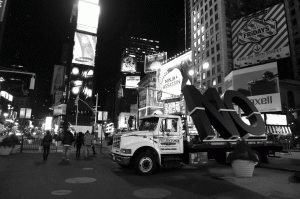Public Art in the Era of Nuits Blanches

Santiago Sierra, No, Global Tour. Times Square, New York, 2009. Courtesy prometeogallery by Ida Pisani/Milano, Lucca and Galeria Helga de Alvear/Madrid.
By Pablo España
Public art that attempts to go beyond mere urban decoration has always had a marked social and even political character. We find ourselves at a moment in time when this practice has become incorporated into the mechanisms of “spectacularization” and institutionalization of contemporary art, where its potential is neutralized.
In order to speak of today’s public art, the first thing we would have to take into account is that often times it has become a simulation of real social policy. It is easy to detect a certain complacency in institutions upon organizing or supporting public art events. Let us take, for example, a festival that appears to be proliferating throughout different points in Europe and the Americas and that arises from the Parisian Nuit Blanche model initiated in 2002. This is an annual artistic event that lasts one night, during which art centers, museums, theaters, and concert halls on an exceptional basis extend their hours until the early morning and open their doors free of charge. Different artistic expressions take place outside of specific buildings, significant city monuments or on streets blocked off from traffic, which are invaded by citizens hungry for culture.
Looking at photos of the different Nuits Blanches around the world: Rome, Genoa, Montreal, Toronto, Berlin, Madrid, Saint Petersburg, Tel Aviv, Sao Paulo, Paris… etc., it is easy to understand all of Adorno’s prejudices against a cultural industry that, for him, was nothing more than part of the Fascist totalitarian universe. In these images of the masses instinctively moving based on cultural experience, we are reminded of the martial choreography of totalitarian exhibitions. Art and culture are utilized as tools of control and mobilization of the masses, as pure propaganda. Culture is becoming more and more concentrated on pure celebration of the cultural act, that is to say, identified with its strictly propagandistic presentation. It is the propaganda of the very authority that backs the event, in this way projecting a desirable image of modernity, in which citizens are favorably shown cultured and learned. It is curious that at these events art is presented as a
No comments:
Post a Comment